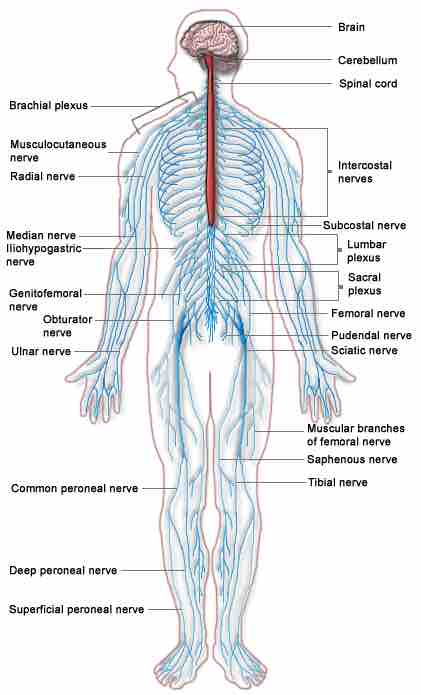The peripheral nervous system (PNS) is one of the two major components of the body's nervous system. In conjunction with the central nervous system (CNS), the PNS coordinates action and responses by sending signals from one part of the body to another. The CNS includes the brain, brain stem, and spinal cord, while the PNS includes all other sensory neurons, clusters of neurons called ganglia, and connector neurons that attach to the CNS and other neurons.

The nervous system
The human nervous system, including both the central nervous system (in red: brain, brain stem, and spinal cord) and the peripheral nervous system (in blue: all other neurons and receptors).
Divisions of the Peripheral Nervous System
The PNS can also be divided into two separate systems: the autonomic nervous system and the somatic nervous system.
Autonomic Nervous System
The autonomic nervous system regulates involuntary and unconscious actions, such as internal-organ function, breathing, digestion, and heartbeat. This system consists of two complementary parts: the sympathetic and parasympathetic systems. Both divisions work without conscious effort and have similar nerve pathways, but they generally have opposite effects on target tissues.
The sympathetic nervous system activates the "fight or flight" response under sudden or stressful circumstances, such as taking an exam or seeing a bear. It increases physical arousal levels, raising the heart and breathing rates and dilating the pupils, as it prepares the body to run or confront danger. These are not the only two options; "fight or flight" is perhaps better phrased as "fight or flight or freeze," where in the third option the body stiffens and action cannot be taken. This is an autonomic response that occurs in animals and humans; it is a survival mechanism thought to be related to playing dead when attacked by a predator. Post-traumatic stress disorder (PTSD) can result when a human experiences this "fight or flight or freeze" mode with great intensity or for large amounts of time.
The parasympathetic nervous system activates a "rest and digest" or "feed and breed" response after these stressful events, which conserves energy and replenishes the system. It reduces bodily arousal, slowing the heartbeat and breathing rate. Together, these two systems maintain homeostasis within the body: one priming the body for action, and the other repairing the body afterward.
Somatic Nervous System
The somatic nervous system keeps the body adept and coordinated, both through reflexes and voluntary action. The somatic nervous system controls systems in areas as diverse as the skin, bones, joints, and skeletal muscles. Afferent fibers, or nerves that receive information from external stimuli, carry sensory information through pathways that connect the skin and skeletal muscles to the CNS for processing. The information is then sent back via efferent nerves, or nerves that carry instructions from the CNS, back through the somatic system. These instructions go to neuromuscular junctions—the interfaces between neurons and muscles—for motor output.
The somatic system also provides us with reflexes, which are automatic and do not require input or integration from the brain to perform. Reflexes can be categorized as either monosynaptic or polysynaptic based on the reflex arc used to perform the function. Monosynaptic reflex arcs, such as the knee-jerk reflex, have only a single synapse between the sensory neuron that receives the information and the motor neuron that responds. Polysynaptic reflex arcs, by contrast, have at least one interneuron between the sensory neuron and the motor neuron. An example of a polysynaptic reflex arc is seen when a person steps on a tack—in response, their body must pull that foot up while simultaneously transferring balance to the other leg.